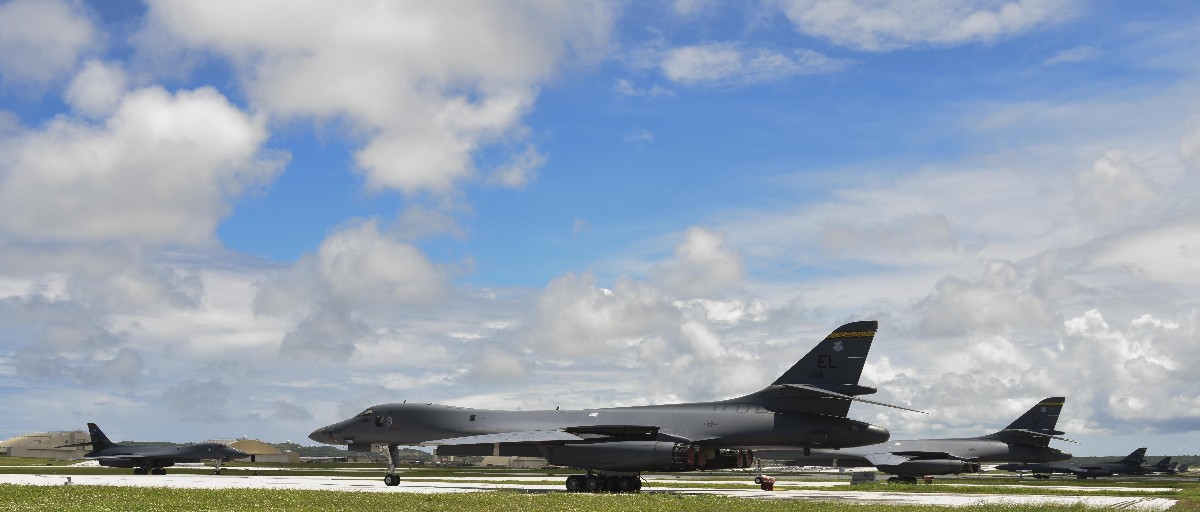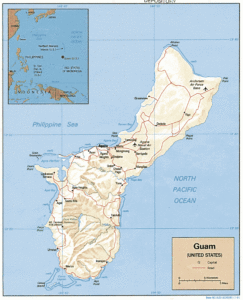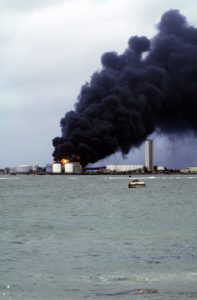
North Korea Threatens Guam Today; Climate Change Threatens it in the Long Term
Update: This work on climate security and Guam was featured in “North Korea Aside, Guam Faces Another Threat: Climate Change” in the August 11, 2017 New York Times.
In the escalating war of words between the United States and North Korea, the commander of the North’s Strategic Forces has threatened to demonstrate its ballistic missile capability with an “Enveloping Fire” of four ballistic missiles around the American military base in Guam. Guam has been a target of North Korean rhetoric before because it is the host to the American strategic bombers that routinely overfly South Korea and could strike deep into North Korean territory. As one of America’s largest military bases outside the continental United States, Guam allows the United States to project force throughout the Far East.
However, when the crisis with North Korea passes, the military will then have to consider how to address another threat to Guam’s military presence: climate change. As affirmed by Congress, the military accepts that a changing climate will threaten security, and is making plans on how to address those impacts.

Guam features significant topography
When we talk about how climate change affects Pacific islands, we are drawn instantly to images of islands sinking beneath the waves. Indeed, low-lying atolls are at risk of being submerged and becoming uninhabitable because of rising seas. This is important for the people living on them, but also for the geostrategic importance of the islands themselves – Kwajalein hosts important elements of America’s ballistic missile defense program and Diego Garcia’s lagoon shelters prepositioned ships equipped with a Marine birgade’s equipment. For more on the risks of losing islands, read “Atlantis 2.0: How Climate Change Could Make States Disappear – and What That Means for Global Security” by Esther Babson and me.
The island of Guam will not sink beneath the waves, even if every bit of ice melts. Guam is not a low-lying atoll. It is a hilly, though not overly mountainous island, with the highest point, Mt. Lamlam, at 1,332 feet. Sea level rise will cause its coastal and beach areas will recede, and coastal portions of Guam will certainly be harmed. However, the main population centers and military installations are inland, and will survive even the worst possible rise in sea levels.
Even so, in 2012, ASP identified Guam as one of the top five most threatened military installations in our fact sheet “Military Basing and Climate Change.” As we discussed in the report, the threat to Guam is not one of existence, but of exposure. Anderson Air Base’s runways are at 612 feet above sea level, so they will never be submerged by rising seas. Guam’s naval base, in Apra Harbor, is – as you would expect – at sea level, but its challenges are similar to others faced around the world.
While Guam’s existence is not threatened, climate change will challenge its readiness for war. Deterrence – a central mission of the strategic bombers that rotate through Guam – requires constant readiness, even in the face of extreme weather. Because of a changing climate, the joint military base on Guam could lose access to essentials like food and water and will be increasingly threated by extreme weather events.
Super typhoons, featuring winds of more than 150 mph, have long been features of the climate of the Western Pacific. Recent trends, abetted by historically high ocean temperatures, appear to show an increase in the number of the most extreme typhoons.

Heavy smoke rises from a fuel depot after Super Typhoon Pongsona. U.S. Navy photo.
Luckily, Guam has not had a direct hit from such a storm in almost 15 years, when Super Typhoon Pongsona struck the island in December 2002. That storm is illustrative of the threat posed to the base by extreme weather. With sustained winds of 150 mph, and gusts up to 185, the storm caused severe damage – over $700 million worth – even though the island is prepared for such storms. The storm cut electricity to the whole island, caused a fuel shortage after a gasoline storage tank in the port exploded, and left about 65% of the islands water wells inoperable. The effect was to leave inhabitants without access to fresh water, electricity, or fuel for days. It is safe to say that running kinetic military operations from Guam in such a situation would have been extremely challenging.
Beyond the acute threats of extreme weather, changes to the climate and waters around Guam could affect the viability of a long-term military presence there. The Department of Defense’s Environmental Research Programs are undertaking a study of Water Resources on Guam to determine the potential impacts of climate change on both surface water and ground water supplies on Guam. Guam is a tropical island with a wet season and a dry season, each of which is heavily affected by broader climactic conditions in the Pacific. The El Nino and La Nina phenomenon can drastically alter weather patterns, with deep droughts during El Nino years. Climate change is expected to both exacerbate those seasonal differences and make the El Nino oscillations more severe. This is important because, as an isolated island, far the American mainland, ensuring supplies of water are available is critical to ensuring the island’s viability as a military base.
Climate change is affecting the waters around Guam as well, with average water temperatures rising more than one degree over the last century. Since 2013, record-breaking water temperatures in the Western Pacific have initiated an outbreak of “coral bleaching” where coral reefs die off due to higher temperatures. Because reefs provide important habitat to marine life – an important part of islanders’ diets – that impacts food security on the island.
So, even if the American military base at Guam manages to survive the direct attention of North Korea, it will face a series of challenges posed by climate change. Unlike some other island bases, the installations and airfields on Guam will continue to exist. However, without investments in resilience, the viability of Guam as base that is always ready to support American national security could be in question. Because strategic deterrence requires that forces be “always ready,” it is important that the Department of Defense invests in the resilience of Guam. The military is capable of preparing for both imminent threats like North Korea and long term threats like climate change.






